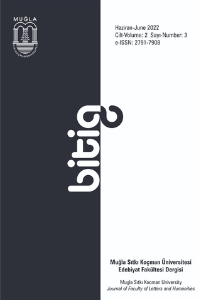Bizans İmparatoru VI. Leo’nun Taktikası’nda Türkler ve “Türk” Anlatısının Askerî Eğitime Katkısı*
The Turks in the Tactica of the Byzantine Emperor Leo VI and Contribution to Military Education of the "Turk" Discourse
___
- Cecaumeni (1965), Strategicon, Ed. B. Wassiliewsky-V. Jernstedt, Amsterdam. Constantine Porphyrogenitus (1967), De Administrando Imperio, Ed. Gy. Moravcsik, Trans. R. J. H. Jenkins, Dumbarton Oaks.
- Incerti Scriptoris Saeculi IX Liber De Re Military (1901), Ed. R. Vàri, Leipzig.
- Vegetius, Flavius (2019), Roma Savaş Sanatı, çev. Samet Özgüler-Kutsi Aybars Çetinalp, İstanbul: Kronik Yayınları.
- Mavrikios (2011), Strategikon, haz. George T. Dennis, çev. Volkan Atmaca, İstanbul: Kırmızıkedi Yayınları.
- Nikephoros Ouranos (1995), Taktika: Sowing the Dragon’s Teeth: Byzantine Warfare in the Tenth Century, trans. E.
- McGeer, Dumbarton Oaks, s. 88-163 Nikephoros II Phokas (1995), Praecepta Militaria:Sowing the Dragon’s Teeth: Byzantine Warfare in the Tenth Century,
- Trans. E. McGeer, Dumbarton Oaks, s. 12-59
- VI. Leo (2010), The Taktika of Leo VI, Text, Translation and Commentary by George Dennis, Dumbarton Oaks.
- Yayın Aralığı: Yılda 2 Sayı
- Başlangıç: 2021
- Yayıncı: Mugla Sitki Kocman University
Basill Liddell Hart - Hitler'in Generalleri Konuşuyor
Ahmed Paşa'nın Gazellerinin Dönüşüm Metaforu Bağlamında İncelenmesi
İnsandan Hayvana Kurban Ritüelinin Değişim ve Dönüşümü: Manas Destanı Örneği
Mehmet Naci ÖNAL, Cansu DAŞDEMİR
Zâtî'nin Nasihatname Kasidesinin İncelenmesi
Ekoeleştirel Perspektiften Edebiyat Alanında Hayvan Çalışmaları
Macbeth: Shakespeare'in Kral VI(I). James'e İthafı mı?
Kayseri Selçuklu Uygarlığı Müzesinde Bulunan Bir Grup Metal Kandil
Süreyya EROĞLU BİLGİN, Vahide KÖSEOĞLU
Bizans İmparatoru VI. Leo’nun Taktikası’nda Türkler ve “Türk” Anlatısının Askerî Eğitime Katkısı*
